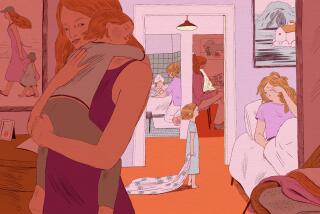Cloth Vs. Disposable: Tangled in a Web of Diaper Choices
- Share via
To most mothers, the Diaper Genie is a modern miracle: a diaper pail that twists used disposable diapers into plastic sleeves to contain the smell.
Long before my son was born, the question of diapering him was opened by a generous friend who offered me her Genie. Without thinking, I declined. But why? Somehow I’d made an unconscious decision to use cloth diapers. This was fortunate, because if I had been conscious, I’d have had my friend hit me on the head with the Genie for even considering it.
As another pal and mother of three put it, “How could you use cloth when disposables have all those wonderful perfumes and dyes?! Don’t you realize that disposable diapers are only a problem for the next generation?”
Naturally, as an inexperienced mother, I thought I knew better. Because the parenting books I had were of no use on the subject, I hit the Internet. Now, there’s no one more anxious than an expectant mother, except perhaps an expectant mother on the Internet. Pregnancy might not be the best time for instantaneous, 24-hour access to thousands of obstetric and pediatric horror stories, but few souls are brave enough to challenge a bloated third-trimester mother-to-be when she wants infant rash statistics at 4 in the morning.
A quick search landed me on a bulletin board inhabited solely by “Clothies,” where I discovered I was not alone in my disdain for the Genie. I discovered, in fact, that there’s currently a mini-resurgence in cloth diapering, due in part to the Internet’s ability to foster niche interests.
Diaper manufacturers say that the use of disposables is at an all-time high; but somehow dozens of new cloth-diapering suppliers are starting up and thriving all over the Internet. So, while this movement may not have captured the hearts and bottoms of a great percentage of Americans, it still represents an opportunity for profit.
The good news: Modern designs with Velcro and snap closures mean you don’t have to stick yourself with pins anymore--unless you really want to. The bad news: Progress comes at a price. The new “fitted” cloth diapers can run to $10 or more apiece--and you need three or four dozen in each size, plus covers. Luckily, you can resell them on what I like to call the used-diaper “brown market,” for up to 50% of their retail value, unless they’re a specialty design, which increase in value when supplies run low.
Higher Costs or More Labor?
Since disposable diapers cost about $1,400 a year and a child needs them for as long as three years, cloth lovers can shop all day and still call themselves frugal, but only as long as they’re willing to discount the labor in washing, folding and shopping.
As I mentioned, if I’d known how complicated the whole issue was going to be, I’d have signed a few grand over to Huggies somewhere in my ninth month and, uh, disposed of the question. But I was not that lucky. No. Instead I found the Diapering Board ladies.
Like many women’s groups organized around duty and biology instead of experience, this group was at first charming and then chilling. The first night I clicked onto the Diapering Board, the ladies were welcoming and gracious, spending what must’ve represented several collective man-hours answering questions about the best cloth-diapering “system” for my son.
They had so many suggestions that I had to devote a second night to investigating all the different brands and types they’d recommended. By the second morning, I’d have a decision. Or so I thought. But it took a full night just to get the vocab right.
The white squares of my infancy aren’t just diapers, they’re prefolds, even though using them involves folding them again. The best prefolds are DSQs (Diaper Service Quality) if they have several layers in the middle, and the best of these are “Chinese Cotton,” made in Pakistan and Mexico. If, however, the diaper resembles nothing so much as a bath towel, it is an “Australian nappy,” not a prefold, and thus requires more pleats and tucks than an origami crane.
I further discovered that I mustn’t refer to a Velcro or snap-closed wrap as a cover, which pulls up, and I shouldn’t confuse a disposable-diaper-styled “fitted” cloth diaper with a contour (the latter are figure-eight shaped flat diapers and virtually useless). Still, some 16 hours into my investigation, I was no closer to a decision on what to buy. With a deep sigh, I devoted another sleepless night to surfing for diaper covers, which come in myriad designs in both high- and low-tech fabrics. This time, I discovered that, counterintuitively, wool was the coolest material, fleece was easier to wash than cotton (because of the treatment that makes it water-resistant) and Gore-Tex was not the futuristic solution it sounded like.
After another long back and forth on the board, I ordered one each of all the diapers that had caught my eye and settled in to await what the ladies called “doing the Diaper Dance” at the arrival of my first batch of “Fluffy Mail.”
It was too late to realize that I’d already been indoctrinated. The Clothies had me--but if you’d asked me, I’d have sworn I could quit at any time. I was no longer investigating the many modes of diapering. Without noticing it, the inquiry itself had become a hobby. I was so intrigued, I couldn’t stop. As I made my solo voyages from Snugglebuns.com to sites with other tooth-decay-inducing names, something compelled me to return to the Diapering Board again and again to confirm my findings with the group.
Something made me visit eight or nine times a day to see what “kayleesmommy” and “osotired” had to add, how much vinegar the board’s experimenters had determined was optimal for the first rinse cycle and what biologically correct laundry soap everyone preferred (Tide Free).
Mommies Who Are Cut From the Same Cloth
Something was driving me, but I had no idea what it was. With 20/20 hindsight, it’s easy to see that this something was anxiety. The anxiety that comes with cloth-diaper shopping is hard to explain, yet nearly every member of the Diapering Board will tell you that she feels the same. In the effort to calm these nerves, Clothies buy so many new and different diapers that jokes about creating a diapering 12-step program are as commonplace as suggestions for hiding the purchases from outraged husbands. Rejecting modern convenience comes only at the price of quixotic second-guessing and reevaluation. Like Puritans fearing that someone somewhere is having fun, Clothies worry that some advantage of the diapering experience has been lost in trade-offs (as in, yes, they’re nicer on baby’s skin, but they’re inconvenient; and yes, they’re more comfortable, until the second they get wet; and sure, they cost less, but they require more labor; and on and on).
This is an anxiety that was notably absent from the Disposable Families I knew. The fact that I’d started to divide people into Cloth and Disposable Families signaled that I needed a break--not to me, of course, but to my desperately bored husband. After one particularly long dinner-time sermon on the environmental advantages of cloth, he begged me to avoid the board for a few days, at least until my first delivery of “Fluffy Mail.”
When my bun covers arrived, they were awfully cute but anticlimactic. These were proto-undies, not a magic system to ward off the storm of upheaval that my first child’s arrival would set off. When I returned to the Diapering Board, it was to pose the question to my fellow obsessors of why we did this--why did we, some of us possessed of advanced degrees, spend hour after hour talking about such issues? In response, the denizens of the board waxed rhapsodic, calling the site their favorite place on the Internet, a place they unironically wrote they “loved,” frequented by people (mostly women, but one man) whom they admired. They’d even liked me until I started asking so many questions.
When I extolled the virtues of diaper services to a newcomer, that was it. Faster than apple juice runs through a toddler, I was the anti-mommy, accused of terrible sins like using Desitin instead of all-natural Calendula, or leaving baby in a wet disposable diaper for more than 20 minutes. Weeks later, for an article on this niche e-business, an economics expert told me he’d found it difficult to study diapering habits. One lady had told him there was nothing more satisfying to her than the smell of fresh diapers from the dryer--and how could he set a price on that? I believed him--many board ladies said their favorite day was washing day, when they got to bask in the sight of their diapers hanging out to dry in the sun.
This washing-day thing was key. More than one board member confessed that using a diaper service felt like “cheating.” Using commercial wipes instead of the flannel home-washed wipes sold alongside the diapers in coordinating fabrics was similar fraud. But who exactly would they be cheating? Not their children. Diaper-service diapers are cleaner, whiter, softer, use 50% less water than the home-washed variety and are treated with a rinse to combat diaper rash. How could a project with so much to recommend it shortchange anyone?
Exposing a Cloth Cult
Nostalgia didn’t fully explain it. Nor did the preppy cotton aesthetic. The more I thought about it, the more I realized I was witnessing a cult. For these women (and that one guy), diapering is not just a way to keep one’s lap dry. With its fragrant oils and distilled waters, its virgin-white cloths, vestment fancies and gestures of humiliating servitude, cloth diapering is nothing short of a rite of purification in the worship of their children.
When at last my son was born, all was forgiven. Not only did I see how tempting it could be to devote my life to singing my child’s praises, but I exulted in the visible relief he enjoyed as the pink irritation disappeared from between his tiny cheeks whenever they were swaddled in cloth. I just wasn’t going to be a martyr to the cloth. Months later, I still haven’t settled on just the right diaper-cover system--but as long as I stay off the board, I don’t care. Sometimes I miss the board--after all, no one else around here understood my grief when my boy outgrew my favorite cover--but out here in the real world I can use a disposable without feeling apostate. Sometimes absorbency trumps comfort, like when Mommy wears dry-clean-only pants.
In the end, the only thing I could find that we board ladies had in common besides cloth was a certain issue of control, a grasp of detail and a voracious appetite for information that would allow us a modicum of command over our children’s least-governable function. When I look back, I see we were all kind of anal.
This essay originally appeared on salon.com. Latham is a freelance writer in Los Angeles whose work has appeared in various publications, from DUCKMAN to the New York Times.






